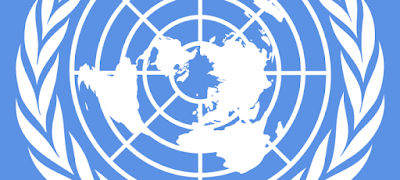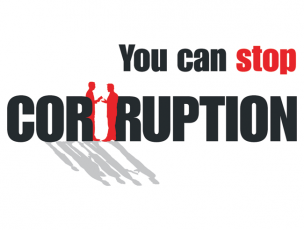 |
| Photo credits – www.integritynigeria.com |
In its resolution 55/61 of
4 December 2000, the General Assembly recognized that an effective
international legal instrument against corruption, independent of the United
Nations Convention against Transnational Organized Crime (resolution 55/25,
annex I) was desirable and decided to establish an ad hoc committee for the
negotiation of such an instrument in Vienna at the headquarters of the United
Nations Office on Drugs and Crime. The
Convention approved by the Ad Hoc Committee was adopted by the General Assembly
by resolution 58/4 of 31 October 2003.
4 December 2000, the General Assembly recognized that an effective
international legal instrument against corruption, independent of the United
Nations Convention against Transnational Organized Crime (resolution 55/25,
annex I) was desirable and decided to establish an ad hoc committee for the
negotiation of such an instrument in Vienna at the headquarters of the United
Nations Office on Drugs and Crime. The
Convention approved by the Ad Hoc Committee was adopted by the General Assembly
by resolution 58/4 of 31 October 2003.
In accordance with article
68 (1) of resolution 58/4, the United Nations Convention against Corruption
entered into force on 14 December 2005. There are 145 signatory countries
to the convention but 178 parties. Countries who are signatory to the Convention
include Afghanistan, Algeria, Austria, Brazil, Canada, Nigeria, China, France,
United Kingdom and United States of America to mention a few.
68 (1) of resolution 58/4, the United Nations Convention against Corruption
entered into force on 14 December 2005. There are 145 signatory countries
to the convention but 178 parties. Countries who are signatory to the Convention
include Afghanistan, Algeria, Austria, Brazil, Canada, Nigeria, China, France,
United Kingdom and United States of America to mention a few.
The Convention requires
countries to establish criminal and other offences to cover a wide range of
acts of corruption, if these are not already crimes under domestic law. Countries
agreed to cooperate with one another in every aspect of the fight against
corruption, including prevention, investigation, and the prosecution of
offenders. Countries are bound by the Convention to render specific forms of
mutual legal assistance in gathering and transferring evidence for use in
court, to extradite offenders. Countries are also required to undertake
measures which will support the tracing, freezing, seizure and confiscation of
the proceeds of corruption.
countries to establish criminal and other offences to cover a wide range of
acts of corruption, if these are not already crimes under domestic law. Countries
agreed to cooperate with one another in every aspect of the fight against
corruption, including prevention, investigation, and the prosecution of
offenders. Countries are bound by the Convention to render specific forms of
mutual legal assistance in gathering and transferring evidence for use in
court, to extradite offenders. Countries are also required to undertake
measures which will support the tracing, freezing, seizure and confiscation of
the proceeds of corruption.

Countries agreed on
asset-recovery, which is stated explicitly as a fundamental principle of the
Convention. This is a particularly important issue for many developing
countries where high-level corruption has plundered the national wealth, and
where resources are badly needed for reconstruction and the rehabilitation of
societies under new governments. Several provisions specify how cooperation and
assistance will be rendered. In particular, in the case of embezzlement of
public funds, the confiscated property would be returned to the state
requesting it; in the case of proceeds of any other offence covered by the
Convention, the property would be returned providing the proof of ownership or
recognition of the damage caused to a requesting state; in all other cases,
priority consideration would be given to the return of confiscated property to
the requesting state, to the return of such property to the prior legitimate
owners or to compensation of the victims.
asset-recovery, which is stated explicitly as a fundamental principle of the
Convention. This is a particularly important issue for many developing
countries where high-level corruption has plundered the national wealth, and
where resources are badly needed for reconstruction and the rehabilitation of
societies under new governments. Several provisions specify how cooperation and
assistance will be rendered. In particular, in the case of embezzlement of
public funds, the confiscated property would be returned to the state
requesting it; in the case of proceeds of any other offence covered by the
Convention, the property would be returned providing the proof of ownership or
recognition of the damage caused to a requesting state; in all other cases,
priority consideration would be given to the return of confiscated property to
the requesting state, to the return of such property to the prior legitimate
owners or to compensation of the victims.
Effective asset-recovery
provisions will support the efforts of countries to redress the worst effects
of corruption while sending at the same time, a message to corrupt officials
that there will be no place to hide their illicit assets. Accordingly, article
51 provides for the return of assets to countries of origin as a fundamental
principle of this Convention. Article 43 obliges state parties to extend the
widest possible cooperation to each other in the investigation and prosecution
of offences defined in the Convention. With regard to asset recovery in
particular, the article provides inter alia that “In matters of
international cooperation, whenever dual criminality is considered a
requirement, it shall be deemed fulfilled irrespective of whether the laws of
the requested State Party place the offence within the same category of offence
or denominate the offence by the same terminology as the requesting State
Party, if the conduct underlying the offence for which assistance is sought is
a criminal offence under the laws of both States Parties”.
provisions will support the efforts of countries to redress the worst effects
of corruption while sending at the same time, a message to corrupt officials
that there will be no place to hide their illicit assets. Accordingly, article
51 provides for the return of assets to countries of origin as a fundamental
principle of this Convention. Article 43 obliges state parties to extend the
widest possible cooperation to each other in the investigation and prosecution
of offences defined in the Convention. With regard to asset recovery in
particular, the article provides inter alia that “In matters of
international cooperation, whenever dual criminality is considered a
requirement, it shall be deemed fulfilled irrespective of whether the laws of
the requested State Party place the offence within the same category of offence
or denominate the offence by the same terminology as the requesting State
Party, if the conduct underlying the offence for which assistance is sought is
a criminal offence under the laws of both States Parties”.
You can download the text of the convention here.
